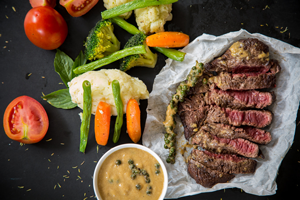
Written by: Lara Moody | January 20, 2022
 Attention to our own health and the health of our planet has given rise to an array of diet recommendations that have advice for optimizing both. Relative to the planet, advocates for reduced meat diets point to the environmental impacts attributed to animal production as a key issue, whereas advocates for meat as a good protein source point to the beneficial role that animal production plays in better soil health and conservation agriculture. Like many concepts, the truth is unclear, understanding the issues around diets and agriculture is complex and many options may be viable, depending on your goals.
Attention to our own health and the health of our planet has given rise to an array of diet recommendations that have advice for optimizing both. Relative to the planet, advocates for reduced meat diets point to the environmental impacts attributed to animal production as a key issue, whereas advocates for meat as a good protein source point to the beneficial role that animal production plays in better soil health and conservation agriculture. Like many concepts, the truth is unclear, understanding the issues around diets and agriculture is complex and many options may be viable, depending on your goals.
Case in point. This month, the article, “Circularity in animal production requires a change in the EAT-Lancet diet in Europe,” was published by researchers from Wageningen University and Research, the Research Institute of Organic Agriculture and Cornell University. If you recall, in 2019, the EAT-Lancet Commission on Food, Planet, Health launched a report that called for drastic reductions in meat and dairy consumption under the guise of protecting public and environmental health and called on global policymakers to take action to disincentivize these food products in the marketplace. The current study assessed the role this diet has in advancing “circularity” in our food and agricultural systems, where we work to reduce waste and further close the loop on our food supply.
The researchers modeled animals fed with only “low-opportunity-cost biomass (LCB),” which is non-human consumed products such as wheat middlings, rendered materials, food waste and grassland resources. Further, they evaluated the nutritional benefits, greenhouse gas emissions and arable land use associated with producing human diets modified to optimize circularity (e.g., less poultry, more beef and dairy and increased use of refined grains) relative to the nutritional requirements of an EAT-Lancet reference diet. With a circularity focus, along with nutrition and the environment, the results encouraged the reader to consider many nuances.
For example, if refined grains are excluded in the human diet within the LCB-based scenario, then animal-based protein production would fall short of the nutritional needs because insufficient LCB products would be created from refined grain production to meet the animals’ feed needs. However, if refined grains were included within the human diet, then the LCB-based production needs would be met because the grain refinement process would create sufficient coproducts for LCB feed. Additionally, while chicken and pork generated fewer emissions during production, poultry and swine’s inability to consume as much LCB-based ingredients as ruminant animals impacted their overall feed footprint.
Overall, the research suggested that in a circular food system, greater quantities of milk, dairy, beef and pork may be optimal rather than elevating poultry-based protein consumption, if the goal is to close the food supply cycle.
The authors biggest takeaway is that compared to the EAT-Lancet reference diet, total GHG emissions were reduced by up to 31% and arable land use was reduced by up to 42% when the circular food system was optimized. In the U.S., animal feed consists of up to 40% of coproducts or byproducts, well short of an exclusively fed animal protein sector.
As I shared in a recent post, opening the door to these considerations invites a broader perspective in human and animal diet considerations that deserve exploration so the consumer can consider the many nuances towards more informed choices.
Comments See our policy on comments